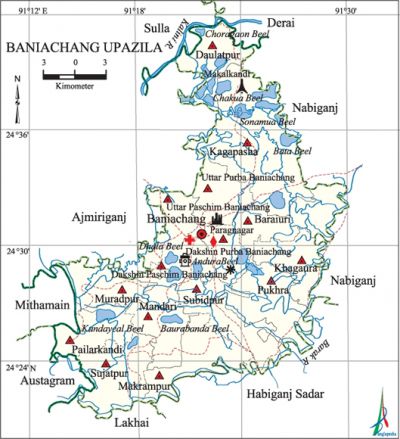Baniachang Upazila
Baniachang Upazila (habiganj district) area 482.25 sq km, located in between 24°21' and 24°41' north latitudes and in between 91°13' and 91°30' east longitudes. It is bounded by derai, sulla and ajmiriganj upazilas on the north, habiganj sadar and lakhai upazilas on the south, Habiganj Sadar and nabiganj upazilas on the east, Ajmiriganj, mithamain and austagram upazilas on the west. Baniachang village is the largest village in Asia continent.
Population Total 268691; male 137912, female 130779; Muslim 215401, Hindu 52799, Buddhist 187 and others 304.
Water bodies Main rivers: kushiyara, Kalni, Kalai; Choragaon, Chakua, Sonamua, Bata, Andura, Dhala, Baurabanda and Kandaiyal beels are notable.
Administration Baniachang thana, now an upazila, was formed in 1790. '
| Upazila | ||||||||
| Municipality | Union | Mouza | Village | Population | Density (per sq km) | Literacy rate (%) | ||
| Urban | Rural | Urban | Rural | |||||
|
- |
15 |
237 |
337 |
22973 |
245718 |
557 |
37.26 |
31.00 |
| Upazila Town | ||||||||
|
Area (sq km) |
Mouza |
Population |
Density |
Literacy rate (%) | ||||
|
3.06 |
7 |
22973 |
7508 |
39.30 | ||||
| Union | ||||
| Name of union and GO code | Area (acre) | Population | Literacy rate (%) | |
| Male | Female | |||
|
Uttar Paschim Baniachang 12 |
4697 |
8955 |
8562 |
38.63 |
|
Uttar Purba Baniachang 06 |
6311 |
10305 |
9785 |
37.83 |
|
Subidpur 94 |
8047 |
6567 |
6282 |
29.36 |
|
Kagapasha 44 |
16572 |
10642 |
10119 |
32.17 |
|
Khagaura 50 |
7026 |
10800 |
10189 |
26.71 |
|
Dakshin Paschim Baniachang 25 |
4795 |
9047 |
8707 |
28.72 |
|
Dakshin Purba Baniachang 18 |
4958 |
9363 |
9003 |
23.52 |
|
Daulatpur 37 |
6816 |
12190 |
11646 |
42.77 |
|
Pukhra 82 |
10061 |
10320 |
9769 |
39.53 |
|
Pailarkandi 75 |
5778 |
8159 |
7686 |
32.05 |
|
Baraiuri 31 |
7520 |
8495 |
8205 |
30.92 |
|
Makrampur 56 |
8431 |
10574 |
9857 |
19.92 |
|
Mandari 63 |
8189 |
8183 |
7566 |
20.23 |
|
Muradpur 69 |
6016 |
6205 |
5856 |
26.12 |
|
Sujatpur 88 |
9915 |
7807 |
7547 |
38.50 |
Source Bangladesh Population Census 2001, Bangladesh Bureau of Statistics.

Archaeological heritage and relics Remnants of ancient Rajbari (Puranbagh, 1737-38), Bibir Dargah Mosque, Bikhangal Akhra.
Historical events A battle was fought between anwar khan (zamindar of Baniachang) and the Mughal army at Baniachang in the first decade of the 17th century. Anwar Khan, in collaboration with the Bara Bhuiyans, faught against the Mughals.
Marks of the War of Liberation Mass killing site 1 (Makalkandi).
Religious institutions Mosque 230, temple 70, tomb 5. Noted religious institutions: Old Kalika Mosque, Puranbagh Mosque, Bibir Dargah Mosque, Akhra of Shyam Baul.
Literacy rate and educational institutions Average literacy 31.54%; male 34.11%, female 28.87%. Educational institutions: college 3, secondary school 22, primary school 51, kindergarten 2, madrasa 23. Noted educational institutions: LR Government High School (1896), Nagura Firm High School, Baniachang Senior Madrasa.
Cultural organisations Library 1, club 26, theatre group 1, community centre 2, musical academy 1, women's organisation 5, playground 4.
Tourist spots Baniachang Rajbari, Sagardighi.
Main sources of income Agriculture 75.01%, non-agricultural labourer 3.89%, commerce 5.89%, transport and communication 0.84%, service 2.19%, construction 1.80%, religious service 0.38%, rent and remittance 1.50% and others 8.50%.
Ownership of agricultural land Landowner 56.83%, landless 43.17%; agricultural landowner: urban 36.19% and rural 58.71%.
Main crops Paddy, wheat, arum.
Extinct or nearly extinct crops Aush and Katari paddy.
Main fruits Mango, black berry, jackfruit, papaya.
Fisheries, dairies and poultries This upazila has a number of fisheries, dairies and poultries.'
Communication facilities Roads: pucca road 25 km, semi-pucca road 12 km, mud road 218 km; waterways 250 nautical miles.
Extinct or nearly extinct traditional transport Palanquin, bullock cart, soari, changari.
Cottage industries Goldsmith, blacksmith, potteries, bamboo work.
Hats, bazars and fairs Hats and bazars are 16, fairs 3, most noted of which are Bara Bazar, Ganing Ganj, Sujatpur Bazar, Bithangal Bazar, Kalibari Mela and Shyam Baul Mela.
Main exports Paddy, fish.
Access to electricity All the unions of the upazila are under rural electrification net-work. However 11.12% dwellings have access to electricity.
Natural resources Natural gas.
Sources of drinking water Tube-well 82.87%, pond 10.12%, tap 0.73% and others 6.28%.
Sanitation 22.69% (urban 38.62% and rural 21.24%) of dwelling households of the upazila use sanitary latrines and 70.83% (urban 55.06% and rural 72.27%) of dwelling houses use non-sanitary latrines; 6.48% of households do not have latrine facilities.
Health centres Upazila health complex 1, union health and family welfare centre 15, family planning centre 12, community clinic 2, private clinic 3, child and mother welfare centre 1, maternity centre 1, charity hospital 2, satellite clinic 5, diagnostic centre 2, veterinary hospital 1.
NGO activities CARE, brac, caritas, asa. [Jayanta Singh Roy]
References Bangladesh Population Census 2001, Bangladesh Bureau of Statistics; Cultural survey report of Baniachang Upazila 2007.
